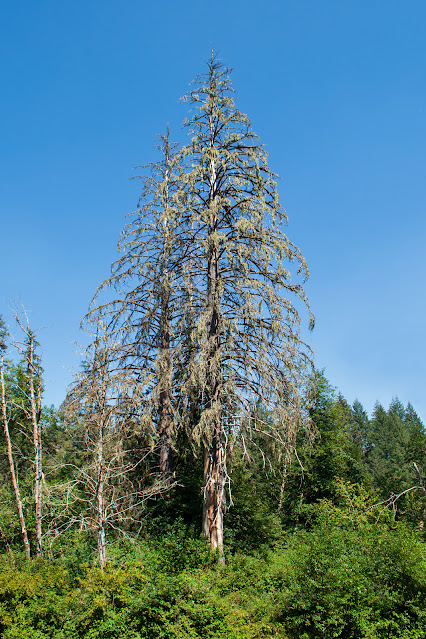Among my old hopeless photos, I found this one:
 |
| Dead tree, Chase Valley |
I've kept this photo, first on paper, then scanned for the computer, for about 10 years. It was a poor photo; too dark, taken from too far away (but it was as close as we could get without gear), with a competing sky behind the tree. Even cleaned up now, it's not very clear. But it was "our" tree, with a story to tell.
We were staying in a friend's cabin
in the hills near Chase, BC. We were basically shut in there; we had no phone, no internet, no neighbours; all around us was scrub bush and evergreen forest, innocent of humans for the most part. Our companions were nuthatches, chickadees, scrub jays and squirrels, hanging around because I was providing seeds and peanuts. There were beaver down by the creek, and we saw a few of those birds that run underwater, the dippers.
To go into town, we had to drive along the bottom of a narrow valley, on gravel roads for part of the way. The view: trees, trees, trees, and the occasional small farm on the bottom land along Chase Creek. I don't remember passing more than one or two cars in the entire time we were there.
Eventually, we would come to civilization; a miniature town hall, seemingly abandoned, a wooden bridge or two, a turn-off down Turtle Valley Road. (That one has a name on the map; our road doesn't.) Then a narrow ravine, a sharp curve, a bit of a slope downwards, and suddenly the world opened in front of us. This was the valley of the river that runs from Little Shuswap Lake, just around the corner, to Kamloops to the west. The fields were lush and bright green, glowing in the sunlight, the river like a mirror held up to the sky. Across the valley the hills started again, rising gradually, melting into a blue haze in the distance. We had to stop to look, often.
And there was the one lone tree, well down the side hill, but still towering overhead.
It was dead, long dead, but still bore life. Every time we stopped, the whole tree was singing and twittering. Sometimes, we saw tiny birds flitting from branch to branch, always dark shadows against the brightness of the sky. We never saw them up close; they remain unidentified. They never seemed to leave the tree; why would they? It was a never-ending source of goodies, bugs and seeds waiting for a forest fire to get them started growing, and free for the eating. No wonder the birds sang!
Eventually we'd tear ourselves away, down into town for groceries and hardware (Laurie was doing some construction work) and a stop at the second-hand book store; then back up that long hill, and we'd dive into the shade of the ravine and the creek valley until next time. The tree stood like a sentinel, watching us return, the birds still twittering madly.
The last time we stopped, to say goodbye for now (but it's been 10 years!) a hawk was perched in a tree above us on the hillside, watching the tree. Next link in the food chain, but I hoped he'd soon go elsewhere.
Is the tree still there? I can't be sure. On the Google satellite photo, there's a dark stain where I think it was. If that's it, I'm sure it's still twittering away.
~~~~~~~~~~~~~~~~~~~~~
Next: I found a whole folder full of trees against the sky. I'll see how many I can rescue.































